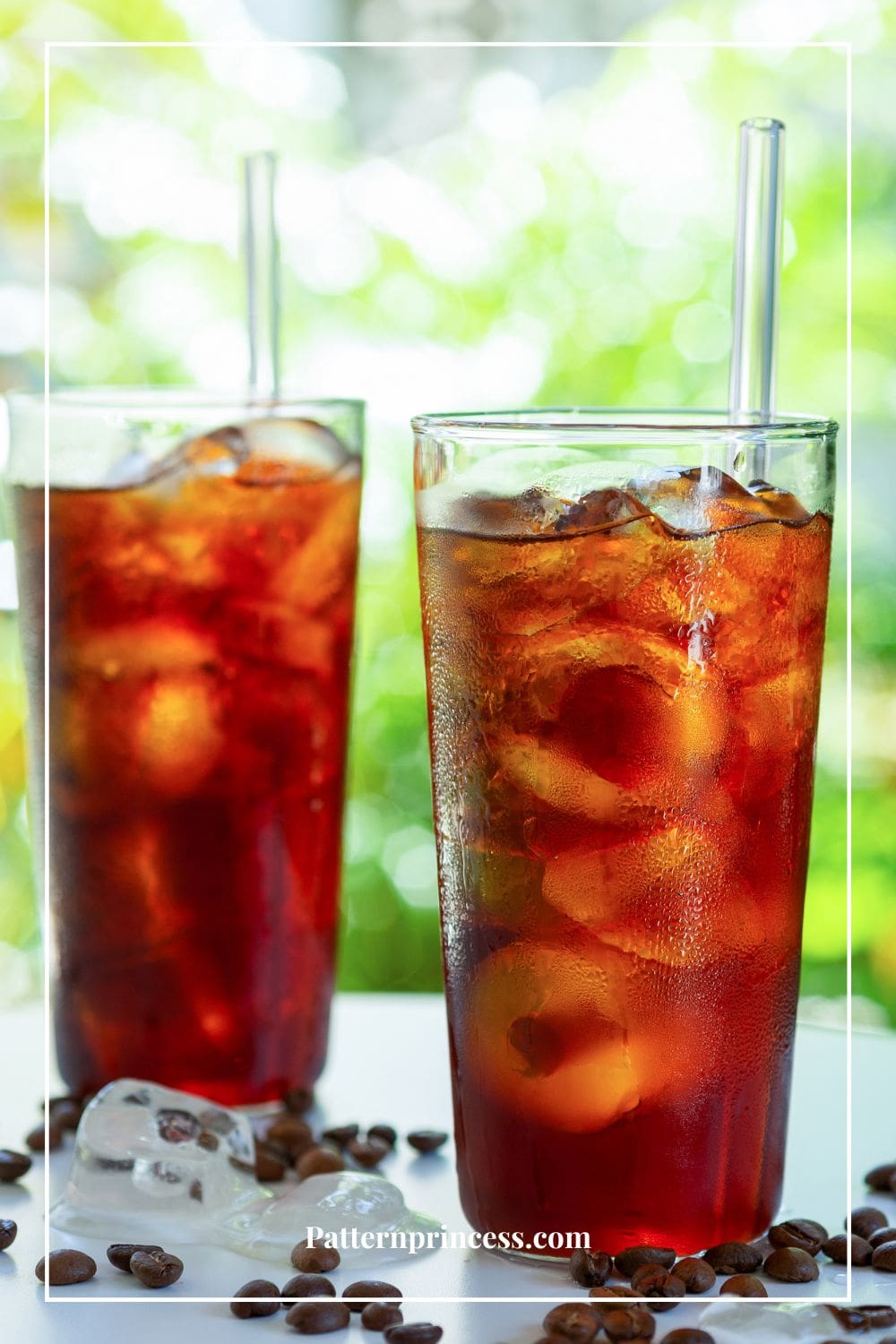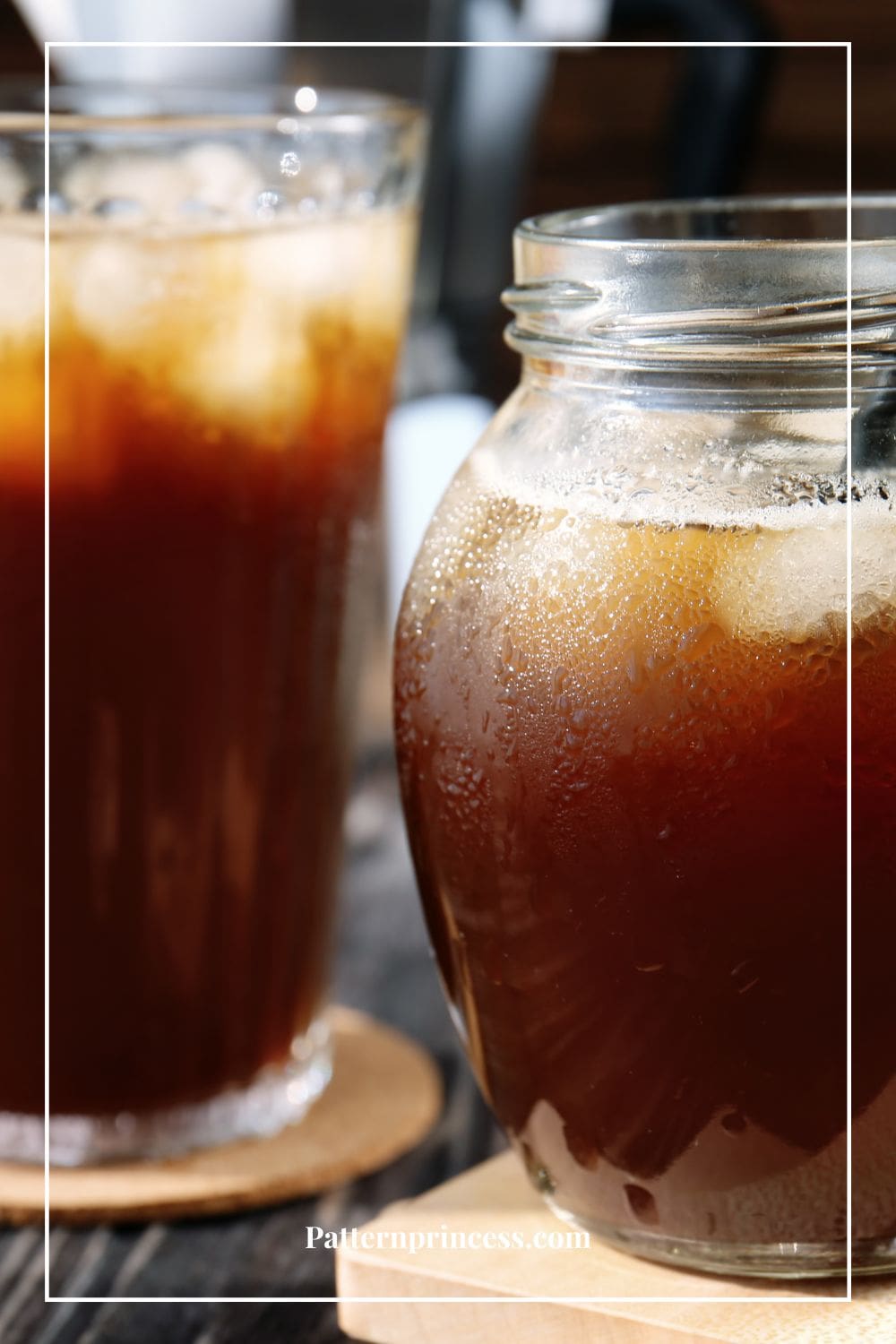Last updated on July 4th, 2024 at 11:32 pm
Cold brew coffee is a method that offers a smooth, less acidic, and refreshing alternative to traditional hot brewing. Whether you’re a seasoned coffee lover or new to the world of cold brew, this beverage is a must try.
Are you a coffee enthusiast searching for a new way to enjoy your favorite beverage? Look no further than this recipe. You need to try this at least once. Get it ready in the evening and quickly grab your cup in the morning as you head out the door.
The Ultimate Guide to Cold Brew Coffee: Brewing, Recipes, and Tips
Are you a coffee enthusiast looking for a refreshing and smooth alternative to your regular cup of joe? Look no further than cold brew coffee.
In this comprehensive guide, we’ll walk you through the basics of cold brew coffee, teach you how to make your own at home. Explore the art of reusing old coffee grounds for second brews, and even delve into exciting variations and serving ideas.

Get ready to unlock the secrets of this beloved brewing method and elevate your coffee experience to new heights.
Post contains affiliate links, and we earn commissions if you shop through the links on this page. For more information, please read the disclosure section under the About Us page.
The Basics of Cold Brew Coffee
Understanding the Cold Brew Method
To embark on our cold brew coffee journey, let’s first grasp the fundamentals of this brewing technique. Cold brew coffee involves a slow extraction process that utilizes time rather than hot water to extract the flavors from the coffee beans. This method produces a smooth and less acidic brew, allowing you to savor the subtle nuances of the coffee.
The Brewing Process: From Coffee Beans to Concentrate
Cold brew coffee starts with quality regular coffee beans. However, it is a good idea to opt for whole beans to preserve the freshness and flavor. Then grind to use fresh grounds for this recipe. We’ll explore different grind sizes and their impact on the brewing process.
Ground Beans: Coarse vs. Fine Grind
Discover the importance of the grind size when it comes to cold brew. Coarse ground beans are typically recommended to prevent over-extraction and bitterness. However, experimentation with finer grinds can yield interesting results too.
Water Temperature and Brew Time
Unlike traditional hot brewing methods, cold brew requires steeping coffee grounds in cold or room temperature water for an extended period. Cold or room temperature is the optimal water temperature and brew time to achieve the desired flavor profile.

Why Cold Brew?
What makes cold brew coffee so special? Let’s explore the advantages that make it a favorite among coffee enthusiasts.
Less Acidic, Smooth Flavor
Cold brew coffee boasts a milder and less acidic taste compared to hot brewed coffee. The slow extraction process reduces the release of certain compounds, resulting in a smoother and more enjoyable flavor profile.
Lower Caffeine Content, Longer Lasting Energy
If you’re looking for a coffee beverage with a gentler caffeine kick, cold brew is the way to go. The extended steeping time leads to all the coffee taste with a lower caffeine content. Providing a sustained and balanced energy boost.
Versatility and Flexibility in Brewing
Cold brew opens up a world of possibilities when it comes to brewing methods and customization. Whether you prefer immersion brewing, using a French press coffee, slow drip towers, or DIY cold brew bags, there’s a technique to suit your preferences.
Making Your Own Cold Brew Coffee
Tools and Ingredients
Now that we understand the foundations of cold brew coffee, let’s gather the essential tools and ingredients to embark on our homemade cold brew journey.
Whole Beans: The Foundation of Flavor
Selecting high-quality whole beans is paramount to achieving a rich and delicious cold brew. Explore different coffee origins and roasts to find your preferred flavor profile.
Burr Grinder: Achieving the Perfect Grind
Invest in a burr grinder to ensure consistency in the grind size. This precision will impact the extraction process and the overall quality of your cold brew.
Coarse grind is most often recommended.
Pro Tip. Sometimes, when grinding the coffee grounds, you might find that they build up a static. This can cause them to stick to surfaces and hard to manage. To combat this, add a few drops of water. If you have the whole grinder hopper full, add up to a teaspoon of water. This works like magic.

Choosing the Right Water
Water quality matters in any brewing process. Opt for filtered or bottled water to eliminate any unwanted flavors that might affect the taste of your cold brew.
Mason Jar or other glass container
The simplest method of making this recipe is adding fresh grounds to cold water and letting sit overnight. The next morning, pass the liquid through a strainer to remove the used grounds. For the best results, use a fine mesh filter and pass the liquid through it a second time.
Cold Brew Recipes and Techniques
Let’s dive into the exciting realm of cold brew recipes and techniques. Discover the various methods you can employ to create your perfect cup of cold brew.
The Classic Method: Immersion Brewing
The immersion method involves steeping coffee grounds in water for an extended period. Add the freshly ground coffee beans to cold water. Give it a gentle stir to make sure all the grounds have contact with the water. Let it sit for 12-72 hours. Strain through a coffee filter lined strainer.
The resulting coffee concentrate can be stored in the refrigerator up to a week.
Cold Brew in a French Press
If you have a French press at home, it can double as a cold brew maker. Learn how to harness its full potential to produce a smooth and flavorful cold brew coffee.
Just like the classic method, allow the coffee to steep for 12-72 hours. Adjust the steeping time according to your taste preferences—longer for a stronger brew, or shorter for a milder cup.
Plunge: After the desired steeping time, slowly press down on the plunger, applying steady pressure. The mesh filter will separate the coffee grounds from the liquid as you push the plunger down.
You’ll still want to strain out the coffee grounds.
Slow Drip Cold Brew Towers
For the adventurous coffee aficionados, explore the fascinating world of slow drip cold brew towers.
Set the drip rate. Adjust the drip valve to control the flow rate of water. A slow drip is ideal for cold brew, allowing the water to gradually saturate the coffee grounds and extract the flavors. Aim for a drip rate of approximately 1 drop per second.
Start the slow drip process. Fill the water chamber at the top of the tower with cold, filtered water. Open the drip valve slightly to allow the water to start dripping onto the coffee bed. Ensure that the water is dripping evenly across the entire surface of the coffee.
Allow the extraction process. Cold brew using a slow drip tower takes time to extract. Depending on your preferences and the desired strength of your cold brew, it can take anywhere from 4 to 12 hours. Monitor the process and adjust the drip rate or water level if necessary.
Collect the cold brew concentrate. Once the desired brewing time has elapsed, the cold brew concentrate will collect in the collection vessel at the bottom of the tower.
DIY Cold Brew Bags or Infusers
If convenience is your priority, DIY cold brew bags or infusers are a game-changer. It can be part of a portable cold brew kit for on-the-go coffee enjoyment. Just place in cup of cold water, let steep 4-5 minutes and enjoy.

Tips for Cold Brew Success
To ensure your cold brew endeavors are met with success, we’ve gathered some valuable tips and tricks to enhance your brewing experience.
Ratios and Measurements: Coffee to Water
Finding the right coffee-to-water ratio is crucial for a well-balanced cold brew. Our recipe will help you achieve your desired strength and flavor. You can adjust the coffee-to-water ratio based on your preference for strength. Start with 1 cup of coffee to 4 cups of water and modify according to your taste.
Steeping Time: Finding Your Preferred Strength
Experimentation is key when it comes to steeping time. Steeping durations will affect the flavor profile. It allows you to customize your cold brew to perfection. If you prefer a smoother and less acidic cold brew, you can steep the coffee mixture in the refrigerator instead of at room temperature. This can help reduce any potential bitterness.
Filtering the Brew: Straining Techniques
Discover various straining techniques to remove the coffee grounds and obtain a smooth, sediment-free cold brew concentrate.
You can use regular coffee filters and either pour the cold brew mixture through the filter after steeping, or steep the coffee in a filter bag for easy removal.
Paper Filter Method: This method involves using a paper filter, such as a coffee filter or cheesecloth, to strain the coffee. Place the filter over a sieve or fine-mesh strainer, and slowly pour the cold brew through it. The paper filter will catch the coffee grounds, resulting in a smooth and clean final product.
French Press Method: If you have a French press, you can use it to strain your cold brew. After steeping the coffee grounds in water for the desired time, press the plunger down slowly to separate the liquid from the grounds. The mesh filter of the French press will effectively strain the coffee, leaving you with a full-bodied brew.
Nut Milk Bag Method: Nut milk bags are made of fine mesh and are commonly used for straining homemade nut milks. They can also be used for straining cold brew coffee. Simply place the nut milk bag in a container or pitcher, pour the cold brew into the bag, and lift it out, allowing the liquid to drain through the mesh while leaving behind the grounds.
Fine-Mesh Sieve Method: If you don’t have any specialized equipment, a fine-mesh sieve can work well for straining cold brew coffee. Position the sieve over a container or pitcher and slowly pour the cold brew through it. The small holes in the sieve will catch the grounds, leaving you with a clear coffee concentrate.
Storing and Using Cold Brew Concentrate
Proper storage of your coffee concentrate, fresh coffee grounds, and old grounds ensure freshness and longevity. We’ll share tips on how to store it and creative ways to incorporate it into various recipes.
- Choose the right container: Opt for an airtight container that is specifically designed for storing liquids. Glass containers with airtight lids are commonly used for storing cold brew concentrate because they don’t impart any flavors or odors to the coffee.
- Cool the concentrate: Before transferring the cold brew concentrate to the storage container, make sure it has cooled down to room temperature or slightly chilled. Hot or warm liquid can create condensation inside the container, leading to potential flavor degradation.
- Fill the container: Pour the cold brew concentrate into the container, leaving a little space at the top to account for any expansion that may occur if you freeze it. It’s important to avoid leaving too much air space, as oxygen exposure can affect the flavor and freshness.
- Seal the container tightly: Ensure that the container’s lid or closure is tightly sealed to prevent air from entering. This helps maintain the quality and prevent oxidation.
- Refrigerate or freeze: Cold brew concentrate can be stored in the refrigerator for up to 1 to 2 weeks. If you want to extend its shelf life, you can freeze it in an airtight container for up to 2 to 3 months. Freezing can help preserve the flavor and freshness, but be aware that the texture may slightly change after thawing.
- Thawing frozen concentrate: When you’re ready to use the frozen concentrate, transfer it to the refrigerator to thaw gradually. This will help maintain its quality. Avoid thawing and refreezing the concentrate multiple times, as it can affect the taste and consistency.
Remember to give the stored cold brew concentrate a good stir or shake before using it, as some sedimentation may occur during storage.

Creative Serving Ideas: Iced Coffee Drinks and More
Unlock the versatility of cold brew by exploring different serving ideas. From classic iced coffee to innovative cold brew creations, we’ll inspire you to elevate your coffee experience.
Reusing Coffee Grounds for Second Brews
The Second Batch Potential
Maximize the potential of your coffee grounds by reusing them from the first brew. The first time is usually the best cup. However, you can use them for a second cup of coffee by making another batch with used grounds. Discover how this sustainable practice can still yield flavorful results.
Maximizing Flavor in a Sustainable Way
Reusing coffee grounds not only reduces waste but can also infuse the second batch with unique flavors. We’ll explore how adjusting the grind size and steeping time can enhance the taste.
Coarser Grind, Longer Steep: Adjusting Brew Time
Learn how to modify the brewing process for your second batch to ensure optimal flavor extraction from reused coffee grounds.
Shorter Brew Time. If you find that your cold brew is too strong or has a bitter taste, you can reduce the brew time. Try decreasing the steeping time by 1-2 hours and see if the flavor improves. This shorter brew time will extract less of the coffee’s oils and compounds, resulting in a lighter and less intense brew.
Longer Brew Time. On the other hand, if you prefer a stronger and more robust cold brew, you can extend the brew time. Increase the steeping time by 1-2 hours and taste the brew periodically to find the desired strength. Keep in mind that longer brewing times can result in a more concentrated and potentially more bitter brew, so be cautious not to over-extract the coffee.
Experiment with Different Times. Brewing time is a matter of personal preference, so feel free to experiment with different durations to find the flavor profile you enjoy the most. You can try increments of 30 minutes to see how the taste evolves with each adjustment. Keep notes on the brew time and the resulting flavor so that you can replicate or adjust it in the future.
Coffee-to-Water Ratio. Adjusting the coffee-to-water ratio is another way to influence the strength of your cold brew. If you find the brew too weak, you can increase the amount of coffee grounds relative to the water. Conversely, if it’s too strong, reduce the amount of coffee grounds. However, it’s important to maintain a balanced ratio to avoid over-extraction or dilution.
Cold Brew with Reused Coffee Grounds: How It Compares
We’ll discuss the differences in taste and nuances between the first and second batch of cold brew, allowing you to appreciate the range of flavors that can be achieved.
Best Practices for Reusing Coffee Grounds
To make the most of your reused coffee grounds, we’ll provide best practices and tips for a successful second batch.
Store and Dry the Used Coffee Grounds. After brewing your initial batch of cold brew, carefully collect the used coffee grounds and allow them to dry thoroughly. Spread them out on a baking sheet or a flat surface and let them air dry for a day or two. This step helps prevent mold or bacterial growth during storage.
Combine Fresh and Used Grounds. To enhance the flavor and strength of the reused coffee grounds, consider combining them with a portion of fresh coffee grounds. This mixture can provide a more balanced extraction and richer taste in your cold brew.
Adjust Brew Time. Since the used coffee grounds have already been steeped once, you may need to adjust the brewing time to achieve your desired strength. Experiment with shorter or longer steeping times until you find the right balance.
Double Strain. When using reused coffee grounds, it’s important to double strain your cold brew to ensure a clean and sediment-free drink. Utilize a combination of paper filters, cheesecloth, or fine-mesh sieves to remove any remaining particles.
Dilute as Needed. Since reused coffee grounds may result in a stronger brew, you might need to dilute the cold brew concentrate with water or milk when serving. Adjust the dilution ratio according to your taste preferences.
Flavorful Additions and Enhancements
Elevate your cold brew experience with enticing flavor additions and enhancements. Here are a few ideas to take your caffeine boost to the next level.
Syrups and Sweeteners
Make homemade or purchase simple syrups and sweeteners to add depth and complexity to your cold brew. From vanilla-infused syrups to honey-based sweeteners, the possibilities are endless.
Experimenting with Spices and Extracts
Spices and extracts can transform your cold brew into a flavor sensation. Explore the world of cinnamon, cardamom, and other spices, as well as extracts like almond and coconut.
Milk and Cream Options: Dairy and Non-Dairy
Explore the diverse range of milk and cream options to complement your cold brew. From creamy dairy milk to plant-based alternatives, find your perfect pairing.
Dairy Options
Heavy Whipping Cream. Heavy whipping cream typically contains a fat content of around 36-40%. The high fat content gives it a rich and creamy texture.
Half and Half. Half and half typically contains around 10-12% fat content. This makes it lighter than heavy whipping cream but richer than regular milk. Half and half has a thinner consistency compared to heavy cream. It is less creamy but still provides some richness to dishes. It has a milder flavor compared to heavy cream.
Whole Milk. Whole milk provides a rich and creamy texture to cold brew while adding a touch of sweetness.
2% or Reduced-Fat Milk. If you prefer a slightly lighter option than whole milk, 2% or reduced-fat milk can be a good choice, offering a balance of creaminess and lower fat content.
Skim Milk. Skim milk is the lowest in fat among dairy options, providing a lighter texture and flavor to cold brew.
Non-Dairy Options
Almond Milk. Almond milk is a popular non-dairy alternative with a slightly nutty flavor. It has a creamy consistency and pairs well with cold brew.
Coconut Milk. Coconut milk lends a tropical flavor to cold brew and adds a rich and creamy texture. It’s a good option if you enjoy the taste of coconut.
Oat Milk. Oat milk has gained popularity for its creamy texture and naturally sweet flavor. It blends well with cold brew and provides a smooth mouthfeel.
Soy Milk. Soy milk is a classic non-dairy option that adds creaminess to cold brew. It has a mild flavor that complements the coffee without overpowering it.
Cashew Milk. Cashew milk has a creamy and velvety texture that works well in cold brew. It adds a subtle nutty flavor to the drink.

Serving and Enjoying Cold Brew
Presentation plays a significant role in enhancing your cold brew experience. Use those unique one-of-a-kind glasses hanging out in your cupboard. Pretty glassware choices and flavor additions go a long way to making a visually appealing and great tasting cup of Joe.
Ice Cube Tray Hack: Avoiding Dilution
Learn a clever hack to prevent your cold brew from becoming diluted when serving over ice. Say goodbye to watered-down drinks.
Use the Cold Brew Ice Cubes. Once the cold brew concentrate cubes are frozen, you can use them in your iced coffee. Simply add the cold brew ice cubes directly to your glass or pitcher, then pour freshly brewed hot coffee or room temperature water over them. As the ice cubes melt, they will slowly infuse the drink with concentrated cold brew flavor, minimizing dilution.
By using cold brew concentrate ice cubes, you can enjoy a chilled coffee that remains strong and full-bodied as the cubes melt gradually, maintaining the flavor profile. This method is particularly useful when you want to avoid dilution while savoring the taste of cold brew.
Use reusable ice cubes. They are plastic or metal cubes you freeze and add to the glass. They will keep your drink cold without adding more water and diluting your drink.
Glassware and Presentation
Discover the art of serving cold brew in style. Showcase different glassware options and presentation techniques to impress your guests or simply elevate your own coffee indulgence.
Cold Brew Cocktails and Mocktails
For those seeking a little adventure, we’ll provide recipes and inspiration for cold brew cocktails and mocktails. Unleash your creativity and craft unique and refreshing beverages.
Armed with knowledge about brewing methods, recipes, reusing coffee grounds, and exploring variations, you’re ready to embark on a delicious and refreshing coffee journey. Whether you’re sipping a classic cold brew or experimenting with exciting flavor combinations, enjoy the smooth and invigorating experience that cold brew coffee brings.
How to Reduce Bitterness of Coffee
Add a pinch of salt to reduce the butter taste. It is amazing how well this works.
Cheers to the perfect cup of cold brew.
The Best Tasting Cold Brew Coffee
As an Amazon Associate I earn from qualifying purchases.
Kitchen Essentials
Ingredients
- 1 Cup Coarsely Ground Coffee
- 4 Cups Cold Water
- Ice cubes
- 1 Tablespoon Milk or sweetener optional
text ingredients
Instructions
- In a large jar or pitcher, combine the coarsely ground coffee and cold water. Stir well to ensure all the coffee grounds are fully saturated.
- Cover the jar or pitcher and let it sit at room temperature for 12 to 24 hours. The longer you steep, the stronger the coffee will be.
- After the steeping time, strain the coffee mixture using a fine-mesh sieve or a coffee filter. Discard the used coffee grounds.
- Fill a glass with ice cubes and pour the cold-brewed coffee over the ice.
- If desired, add milk or sweetener to taste. Stir well.
- Serve the cold-brewed iced coffee immediately and enjoy.
Your Own Private Notes
Notes
Tips for Recipe Success
Use coarsely ground coffee
Coarse grounds are preferred for cold brew as they allow for a slower extraction process and help prevent the brew from becoming too bitter.Experiment with coffee-to-water ratio
You can adjust the coffee-to-water ratio based on your preference for strength. Start with 1 cup of coffee to 4 cups of water and modify according to your taste.Steep in the refrigerator
If you prefer a smoother and less acidic cold brew, you can steep the coffee mixture in the refrigerator instead of at room temperature. This can help reduce any potential bitterness.Store leftover cold brew
If you have leftover cold-brewed coffee, the best way to store it is to transfer it to a sealed airtight container and store it in the refrigerator. It can stay fresh for up to 1 week, allowing you to enjoy iced coffee whenever you like.Nutrition
A few of my favorite things
The Power of Positivity

You can find Victoria crocheting, quilting, and creating recipes. She has cooked in restaurants for over 20 years, including many larger parties. She learned to crochet when she was just 11 years old and has been crocheting ever since; over 50 years now. Over 40 years ago, she loved her first class in sewing and continues to hone her skills in quilting. Many have enjoyed the handmade gifts over the years. In her professional career, she has worked in management in a wide variety of businesses including higher education as a dean of a division. All the while attending college part-time to achieve her doctorate in higher education with an emphasis in e-learning.




